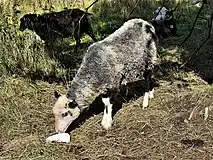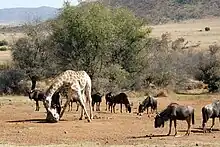Mineral lick
A mineral lick (also known as a salt lick) is a place where animals can go to lick essential mineral nutrients from a deposit of salts and other minerals. Mineral licks can be naturally occurring or artificial (such as blocks of salt that farmers place in pastures for livestock to lick). Natural licks are common, and they provide essential elements such as phosphorus and the biometals (sodium, calcium, iron, zinc, and trace elements) required for bone, muscle and other growth in herbivorous mammals such as deer, moose, elephants, tapirs, woodchucks, fox squirrels, mountain goats, porcupines, and frugivorous bats.[1] Such licks are especially important in ecosystems such as tropical rainforests with poor general availability of nutrients. Harsh weather exposes salty mineral deposits that draw animals from miles away for a taste of needed nutrients. It is thought that certain fauna can detect calcium in salt licks.[2]

Overview
Many animals regularly visit mineral licks to consume clay, supplementing their diet with nutrients and minerals. In tropical bats, lick visitation is associated with a diet based on wild figs (Ficus), which have very low levels of sodium,[3][4] and licks are mostly used by females that are pregnant or lactating.[5]
Some animals require the minerals at these sites not for nutrition, but to ward off the effects of secondary compounds that are included in the arsenal of plant defences against herbivory.[6] The minerals of these sites usually contain calcium, magnesium, sulfur, phosphorus, potassium, and sodium.[7][8][9][10] Mineral lick sites play a critical role in the ecology and diversity of organisms that visit these sites, but little is still understood about the dietary benefits.
The paths animals made to natural mineral licks and watering holes became the hunting paths predators and early humans used for hunting. It is hypothesized that these salt and water paths became trails and later roads for early humans.[11]
Nonetheless, many studies have identified other uses and nutritional benefits from other micronutrients that exist at these sites, including selenium, cobalt and/or molybdenum.[12][13] In addition to the utilization of mineral licks, many animals suffer from traffic collisions as they gather to lick salts accumulated on road surfaces. Animals also consume soil (geophagy) to obtain minerals, such as moose from Canada mining for minerals from the root wads of fallen trees.[14][15]
Artificial salt licks
Artificial salt licks are used in the husbandry of livestock and to attract or maintain wildlife, whether it be for viewing, photography, farming, or hunting purposes.[16] Maintaining artificial salt licks as a form of baiting is illegal in some states in the United States, but legal in others.[10]: 413 Inadvertent salt licks may lead to unintended wildlife–human interactions.[17]
 Svärdsjö sheep, an endangered Swedish local breed, licking salt
Svärdsjö sheep, an endangered Swedish local breed, licking salt

History
In the Americas
The indigenous peoples of the Americas and the longhunters watched salt licks to hunt game. Many became well-known, including Bledsoe Lick in Sumner County, Tennessee; the Blue Lick in central Kentucky; 'Great Buffalo Lick' in Kanawha Salines, now present-day Malden, West Virginia; the French Lick in southern Indiana; and the Blackwater Lick in Blackwater, Lee County, Virginia.[18]
Mythology
In Norse mythology, before the creation of the world, it was the divine cow Auðumbla, who – through her licking of the cosmic salt ice – gave form to Búri, ancestor of the gods and grandfather of Odin. On the first day as Auðumbla licked, Buri's hair appeared from the ice, on the second day his head, and on the third his body.[19]
See also
References
- Bravo, Adriana; Harms, Kyle E.; Stevens, Richard D.; Emmons, Louise H. (2007). "Collpas: Activity Hotspots for Frugivorous Bats (Phyllostomidae) in the Peruvian Amazon". Biotropica. Wiley. 40 (2): 203–210. doi:10.1111/j.1744-7429.2007.00362.x.
- C. Michael Hogan. 2010. Calcium. eds. A.Jorgensen, C.Cleveland. Encyclopedia of Earth. National Council for Science and the Environment.
- Bravo, Adriana; Harms, Kyle E.; Emmons, Louise H. (2012). "Keystone resource (Ficus) chemistry explains lick visitation by frugivorous bats". Journal of Mammalogy. 93 (4): 1099–1109. doi:10.1644/11-mamm-a-333.1.
- Bravo, Adriana; Harms, Kyle E. (2017). "The biogeography of sodium in Neotropical figs (Moraceae)". Biotropica. 49 (1): 18–22.
- Bravo, Adriana; Harms, Kyle E.; Emmons, Louise H. (2010). "Puddles created by geophagous mammals are potential mineral sources for frugivorous bats (Stenodermatinae) in the Peruvian Amazon". Journal of Tropical Ecology. 26 (2): 173–184. doi:10.1017/s0266467409990472.
- Voigt, C. C.; Capps, K. A.; Dechmann, D. K. N.; Michner, R. H.; Kunz, T. H. (2008). "Nutrition or detoxification: Why bats visit mineral licks of the Amazonian rainforest". PLOS ONE. 3 (4): e2011. Bibcode:2008PLoSO...3.2011V. doi:10.1371/journal.pone.0002011. PMC 2292638. PMID 18431492.
- Emmons, L. H.; Stark, N. M. (1979). "Elemental composition of a natural mineral lick in Amazonia". Biotropica. 11 (4): 311–313. doi:10.2307/2387925. JSTOR 2387925.
- Black, J. G.; Mosquera, D.; Guerra, J.; Loiselle, B. A.; Romo, D.; Swing, K. (2011). "Mineral licks as diversity hotspots in lowland forest of eastern Ecuador". Diversity. 3 (2): 217–234. doi:10.3390/d3020217.
- Ayotte, J. B.; Parker, K. L.; Gillingham, M. P. (2008). "Use of natural licks by four species of ungulates in northern British Columbia". Journal of Mammalogy. 89 (4): 1041–1050. doi:10.1644/07-MAMM-A-345.1.
- Atwood, T. C.; Weeks, H. P. (2003). "Sex-specific patterns of mineral lick preference in white-tailed deer". Northeastern Naturalist. 10 (4): 409–414. doi:10.2307/3858657. JSTOR 3858657.
- "A Brief History of Salt". Time. 1982-03-15. ISSN 0040-781X. Retrieved 2018-04-16.
- Mills, A.; Milewski, A. (2007). "Geophagy and nutrient supplementation in the Ngorongoro Conservation Area, Tanzania, with particular reference to selenium, cobalt and molybdenum". Journal of Zoology. 271 (1): 110–118. doi:10.1111/j.1469-7998.2006.00241.x.
- Ayotte, J. B.; Parker, K. L.; Arocena, J. M.; Gillingham, M. P. (2006). "Chemical composition of lick soils: Functions of soil ingestion by four ungulate species". Journal of Mammalogy. 87 (5): 878–888. doi:10.1644/06-MAMM-A-055R1.1.
- Rea, R. "Mining and geophagy of root wad soils by moose in winter" (PDF). Wildlife Afield. 4 (1): 86–87. Archived from the original (PDF) on 2012-03-25.
- Klassen, N. A.; Rea, R. V. (2008). "What do we know about nocturnal activity of moose?". Alces. 44: 101–109.
- "Managing the Deer Herd on Your Ranch | Hortenstine Ranch Company". Hortenstine Ranch Company. 2017-10-03. Retrieved 2018-10-03.
- Elassar, Alaa (22 November 2020). "Canadian officials warn drivers not to let moose lick their cars". CNN. Retrieved 3 December 2020.
- "My Long Hunters - Blackwater, VirginiaBlackwater, Virginia - My Long Hunters". mylonghunters.info.
- Prose Edda by Snorri Sturluson
Further reading
- Kurlansky, Mark (2002). Salt: A World History.Walker and Co. ISBN 0-8027-1373-4.
External links
 Media related to Salt licks at Wikimedia Commons
Media related to Salt licks at Wikimedia Commons